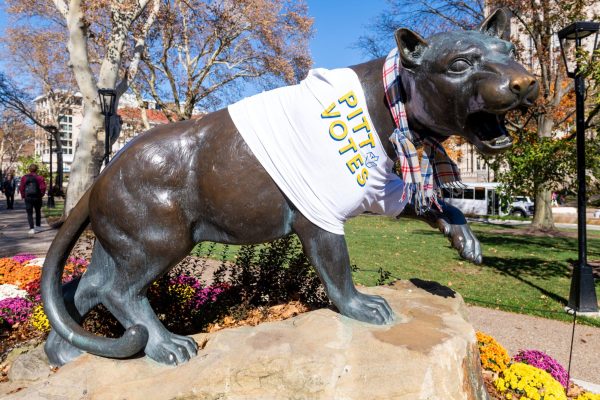Artist Katrina d’Autremont bridges gap between family, culture
February 15, 2010
“Si Dios Quiere” (If God Wants)
Katrina d’Autremont
Silver… “Si Dios Quiere” (If God Wants)
Katrina d’Autremont
Silver Eye Center for Photography
1015 East Carson St.
412-413-1810
Families are a difficult subject.
We love them, we hate them, we need to live with them or we want to get away from them.
But photographer Katrina M. d’Autremont doesn’t shy away from exposing family issues. Instead, she lets us get up close and personal with her own family.
Photos from her exhibit “Si Dios Quiere” (If God Wants), currently displayed at the Silver Eye Center for Photography, explore the dynamics of space between relationships and generations all within a time span of two weeks spent in her family’s apartment in Argentina.
In “Abuelo y Maria Esther,” a couple sits on opposite ends of a couch with deadpan faces as d’Aurtemont’s face reflects in the window from across the room. This family is all in one room, but with nothing left to say.
“Closer proximity to the people we love can be just as complex as distance,” she said in her artist statement.
The Philadelphian artist won the Silver Eye’s 2009 Fellowship Competition, which includes a cash award and three month exhibition at the gallery. She competed against 186 other submissions from among 32 states.
Fellowship juror Andy Adams, editor of Flak Photo, describes d’Aurtemont’s photos as “a shoebox of snapshot memories, her pictures depict the private rituals that comprise a family’s life.”
Born in Denver, d’Aurtemont grew up with an American father and an Argentinean mother. She spent several years after college traveling in South America and visiting her mother’s family in Buenos Aires, and she currently resides in Philadelphia.
The bilingual titles and product imagery in her photographs emulate the idea that both cultures figure significantly as a part of her identity.For example, in the dinner scene depicted in “La Mesa,” a bottle of Coke sits on the table. Although this product is easily recognizable to the average American, something feels slightly different about the bottle’s shape and size, signifying the slightest cultural difference.
Other photos are in English, such as “Piano” and “Curtains.” Rebecca Lewis, the center’s marketing manager, explained that “the way her process works is that she’ll look at something and think of one thing in Spanish and one in English and it’s very sort of mixed.”
Most of d’Aurtemont’s photos are available online, but seeing them in the gallery is another experience entirely, because all the photos are framed in different sizes.
“She wanted them to feel like the apartment feels. The frames are intended to match the framing in the photograph,” Lewis said.
Katrina repeats characters and rooms in photographs so viewers can map an image of the entire apartment in their head.
One of her most profound characters, her “abuelo” or grandfather,is featured in the center of three photos. He sits still and stoic, resembling a figure from an early daguerreotype photograph.
The brown, red and blue hues give a warm feel and the lighting appears natural. She leaves the glares in glass-framed pictures and the sun’s rays sometimes appear to be the only lighting in the room.
Through each snapshot, d’Aurtemont tells the story of her family, leaving the empty space between furniture and people up to the viewer’s imagination.
“The great thing is that it makes you ask questions and you kind of figure the pictures out for yourself,” Lewis said.
Although families can be a difficult issue for all of us, it’s hard not to look at these photos without feeling some sense of home, memory and belonging.
“It really has a warm feeling, which is really nice in the winter,” Lewis said.
The exhibit is free and runs until March 20. The gallery is open Tuesdays through Saturdays from noon until 6 p.m.






